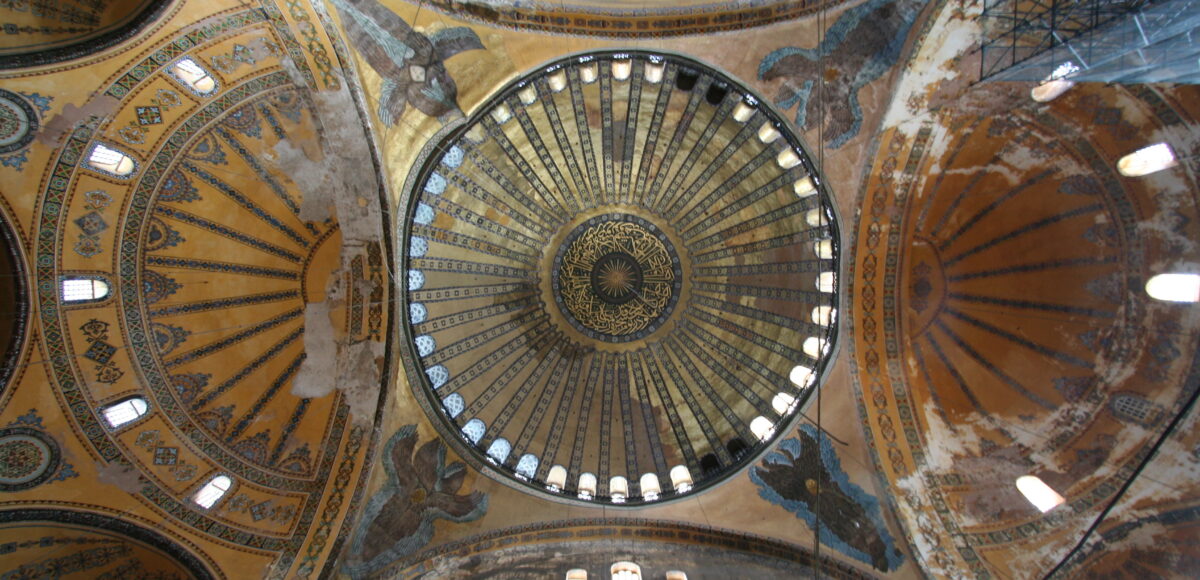One of the most innovative and beautiful buildings in the world has meant many things to many people over the course of its 1500 year history — and its identity is being contested once again. What is at stake in its (until very recent) designation as a “museum”?
Here are the images we’ll be looking at.
Readings:
- Watch this video: They Might Be Giants, Istanbul (Not Constantinople), so that you get my jokey title and because it’s great.
- Hagia Sophia on Smarthistory (video and text)
- Three op-eds from mid-July, 2020, in the New York Times (read in this order):
– Editorial Board, “The Hagia Sophia was a Cathedral, a Mosque and a Museum. It’s Converting Again.” 7/22/20
– Selim Koru, “Turkey’s Islamist Dream Finally Becomes a Reality,” 7/14/20
– Mustafa Akyol, “Would the Prophet Muhammad Convert Hagia Sophia?” 7/20/20
Model exam answers:
- I believe that in this case, the history of the Hagia Sophia stands somewhat apart from other museums and that the Unesco statement is appropriate. While it’s true that museums are frequently misleading about a universal past and aren’t truly open to dialogue, I don’t think that is the case here. The other museums we have looked at, like for example the British Museum in the context of the Elgin marbles, have always been trying to enforce or push a message or single narrative. In that case, it was that the marbles were safer in London than in Greece. Another example is the Museum of Romanness at Nimes. In this example, they utilize their single-story to gain attention when in reality the back story of the area is much more complex than they make it appear. I think the Hagia Sophia is different from these two in that, in my limited knowledge, I think it has experienced both sides of the conflict. It was built as a Christian church and then converted into a mosque and then later a museum. I think that given its well-known history, it is impossible for there to be a single story about it. Although, its recent conversion back into a mosque seems to be an indication of an attempt by the Turkish president to reintroduce a single story of its history. The recent conversion makes it seem like it should be a mosque and has always been a mosque when that is simply not true. I think as a museum, it does have the potential for powerful dialogue given its complex but well-known history and that forcing into a label of either Christian or Islamic hinders that dialogue. I think this is best shown by the third Op-ed, when the author mentions the idea that Islam and other religions should collaborate, not be in conflict.
- The New York Times use of the UNESCO quotation is a clear example of Western bias towards museums over cultural heritage. The claim that it has a “universal nature” implies that the Hagia Sophia’s role should be for the international community rather than just Turkey. While I would agree that the Hagia Sophia should be enjoyed by as many people as possible and that status of a museum would facilitate this goal, I am coming from a western bias that aims to secularize religious monuments like this. Museums are a western creation and many where filled with the treasures of colonialism. The declaration of the Hagia Sophia as a museum has a similar effect. It removes the significance of the Hagia Sophia from the Turks even when it is in their own country. I do not suggest that historical landmarks like the Hagia Sophia should be under complete control of their origin country: it would be unacceptable to allow Turkey to reduce it to a pile of rubble. However, there is a historical trend for Western culture to overvalue the sites aesthetic and historical appeal over its actual purpose. The Hagia Sophia is a religious site and many believe it should be used as such. Many Catholics would not accept that the Notre Dame be declared a museum and religious ceremonies stopped. Overall, this points to the general trend with museums that the Western enjoyment of artifacts or sites outweighs their cultural significance to their home country. Whether it is the Elgin Marbles, or Turkish Bronzes, museums argue that their purpose is the preservation of history while they plunder the cultural riches of weaker countries. Museums are in no way unbias arbitrator of history. In the case of the Hagia Sophia, Atatürk’s goal was to westernize and secularize the country. This historic site was part of that conversion. As we can see in the Koru editorial this was not a welcome process for all Turks, but their perspective was silenced. Overall, the Hagia Sophia’s status as a museum is a continuation of Western colonialism as our enjoyment of antiquity outweighs country’s own soviergnty and goals.
